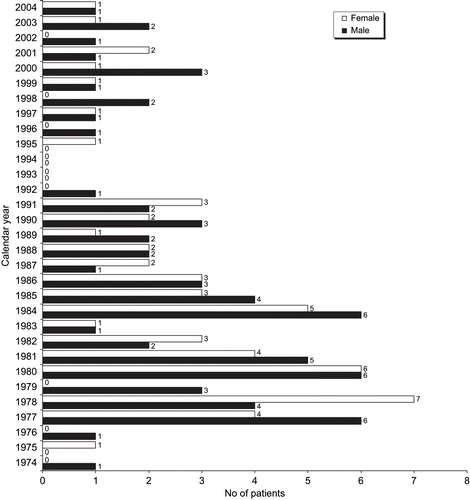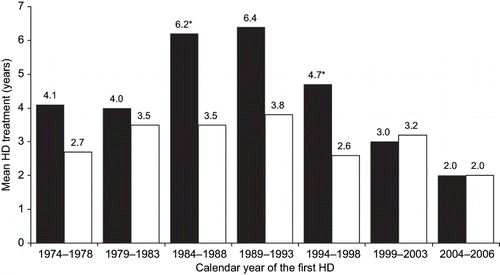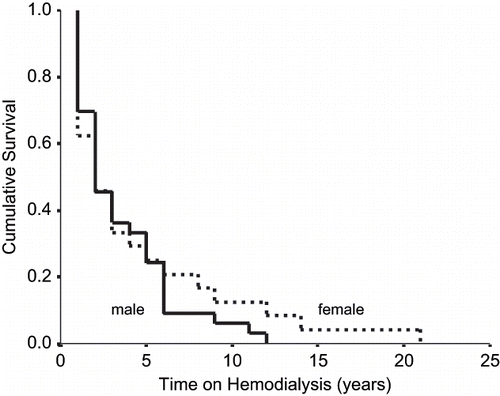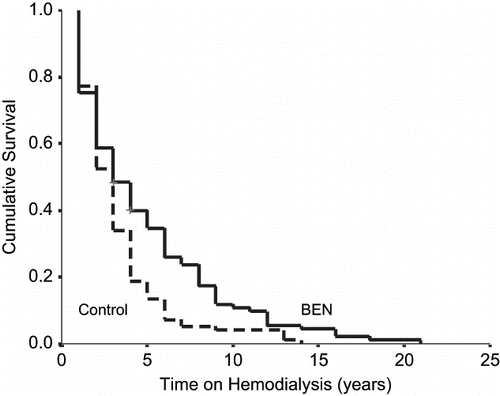Abstract
Aim. To analyze hemodialysis (HD) treatment of patients with Balkan endemic nephropathy (BEN) from five endemic villages in the South Morava Region of Serbia. Analyses of patterns of incidence may generate hypotheses about the underlying causes of BEN, and prevalence data provide information on the current and likely future burden on health services for managing BEN. Methods. A total of 143 end-stage kidney disease patients (ESKD) with BEN were admitted to the renal replacement program from 1974 to 2004: 121 to HD, 15 peritoneal dialysis, and 7 kidney transplantation. As a control group, 117 patients with other kidney disease (chronic pyelonephritis, glomerulonephritis, and ischemic nephropathy) admitted to HD at the time of BEN patients and matched by age and gender were studied. Results. Most of the BEN patients (93.4%) treated by HD were born from 1917 to 1941. The majority of patients (79.3%) started HD from 1977 to 1991 (period of 15 years). The mean age of BEN patients starting HD treatment was 49.1 years in the period from 1974 to 1978, and increased steadily in the following years, being 72.5 years in the last period of study (2004–2006) The mean survival time of BEN males was 4.70 (95% CI 3.66–5.75) and for females was 5.02 (95% CI 1.47–4.53). Difference between males and females was not statistically significant (log rank 0.14, p = 0.7, P > 0.5). Mean survival times of 4.84 (95% CI 3.97–5.70) in BEN patients and 3.1 (95% CI 2.78–3.84) in other kidney disease patients were found. Difference between BEN patients and controls was statistically significant (log rank 8.38, p = 0.0038, P < 0.01). Conclusion. The population of endemic villages around the South Morava River admitted to HD treatment after 1974 was exposed to environmental toxicant(s) from 1917 to 1941. The most intense effect of environmental exposure was in that period, with ESKD in patients in their forties. The exposure to environmental toxicants has diminished, so ESKD of BEN has become less frequent and manifested in the older age, mean 72.5 in the period from 2004 to 2006. Different type of exposure was registered in some other endemic regions in Serbia and abroad.
Balkan endemic nephropathy (BEN) is a familial chronic tubulointerstitial disease with insidious onset and slow progression to end-stage kidney disease (ESKD). It was first described in Serbia by Danilovic et al. in 1957Citation[1] and affects people living in the alluvial plains along the tributaries of the Danube River in Serbia, Bosnia, Croatia, Bulgaria, and Rumania.Citation[2] The disease usually affects adults in their forth or fifth decade with eventual ESRD in their fifth or sixth decade. No case has been documented in children and adolescents. The age distribution is increasingly skewed toward the elderly.Citation[3] The median age of incident cases has increased by 5.5 years between the 1970s and 1980s, and by another 7.5 years between the 1980s and 1990s, a trend paralleled by the associated urothelial carcinoma.Citation[4] The incidence of ESKD and BEN death rates has decreased between 1978 and 1997 in the South Morava region as well as in some areas in Serbia.Citation[5] Data on survival of BEN patients and their kidneys are scant. At the time when BEN was described in 1957, the clinical course of the disease was very rapid, with ESRD within months.Citation[1] After 12 years of follow-up of 265 BEN patients, diagnosed in 1971 in endemic villages of the municipality of Lazarevac, Velimirovic reported an average survival of 7.4 years for patients in the early clinical phase of BEN and 5.7 years for patients with chronic renal failure.Footnote[6] In a retrospective cohort study of 97 BEN patients discovered in 1971 in a field examination in the village of Sopic, an analysis performed 27 years later has revealed the mean survival time of 16.4 years for all patients, 23.1 for suspected and 13.3 for manifested patients.Citation[7] Clinicopathologic correlation has shown that progression from marked tubulointerstitial damage and advanced renal failure (99mTc-DTPA clearance 28 mL/min/1.73 m2) to ESKD could be prolonged by 11 years (GFR decrease of 2.1 mL/min per year) with the appropriate treatment.Citation[8] If no regular medical supervision was accepted by patient, progression is much faster (GFR decrease of 5.1 mL/min per year). Hemodialysis (HD) treatment of BEN patients was found to be a safe and successful method of treatment of ESKD.Citation[9] However, survival of BEN patients on maintenance HD was not analyzed.
The aim of our study was to analyze HD treatment of patients with BEN from five endemic villages in the South Morava Region of Serbia. Analyses of patterns of incidence may generate hypotheses about the underlying causes of BEN, and prevalence data may provide information on the current and likely future burden for health services for managing BEN.
SUBJECTS AND METHODS
Subjects
A total of 143 end-stage kidney disease patients (ESKD) with Balkan endemic nephropathy from five endemic villages (Brestovac, Kutles, Mezgraja, D. Trnava, and Nozrina) in the South Morava Region of Serbia were admitted to the renal replacement program from 1974 to 2006. Endemic villages were carefully selected to represent BEN population. There were 121 patients (55 female, 66 male) on HD, 15 with peritoneal dialysis, and 7 with kidney transplantation. The hemodialysis program at the Institute of Nephrology and Hemodialysis, Faculty of Medicine, Nis, was introduced in 1973. The individuals were diagnosed as having BEN according to the current diagnostic criteria.Citation[10] Age, gender, year of birth, year starting HD, and mortality on HD were analyzed. As a control group, 117 patients with other kidney disease (chronic pyelonephritis, glomerulonephritis, and ischemic nephropathy) admitted to HD at the time of BEN patients and matched by age and gender were studied.
Statistical Analysis
The results are expressed as means or medians. Student's t-test and non-parametric analysis (Mann-Whitney) were used when appropriate. Differences were considered significant at p < 0.05. Kaplan Meir test was used to analyze survival of HD patients.
RESULTS
Most of the BEN patients treated by HD were born from 1917 to 1941 (see ). In a period of 25 years, 113 out of 121 BEN patients (93.4%) were born. The number of male and female BEN patients who started HD from 1974 to 2006 is presented in . Most of the patients (79.3%) started HD from 1977 to 1991, a period of 15 years. Maximum was 12 patients in one year (1980), followed by 11 patients in 1978 and 1984. No BEN patient from these five endemic villages started HD in 1993 and 1994, and only one started HD in 1974, 1975, 1976, 1992, 1995, and 1996. Mean age of BEN patients starting HD treatment was 49.1 years in the period from 1974 to 1978, increasing steadily in the following years to 67.6 in the period from 1994 to 1998 and finally 72.5 years from 2004 to 2006 (see ). Mean age of patients in the control group was similar to that of BEN patients. Age at the start of HD in the population of BEN natives, emigrants, and immigrants to the endemic region is presented in . Most (38) BEN patients started HD at the age of 51–60 years, natives at the median age of 56. Natives of the endemic villages in the age group of 61–70 years started HD at the median age of 65, as did emigrants from these villages. There was a small group of BEN patients starting HD in the age over 70 years; the median age in both natives and emigrants was 74 years. BEN patients starting HD from 1974 to 1978 had a mean time of survival on HD of 4.1 years; in the period from 1984 to 1988, it was 6.2, but decreased to 4.7 from 1994 to 1998, 3.0 from 1999 to 2003, and finally 2.0 from 2004 to 2006 (see ). The survival of patients with other kidney disease was similar to that of BEN patients in the years 1974 to 1983 and 199 to 2006 of the first HD (see ). Survival of BEN patients starting HD from 1984 to 1998 was significantly higher (p < 0.05) than that of patients with other kidney disease. Kaplan-Meir analysis of survival was performed (see ). The mean survival time of BEN males was 4.70 (95% CI 3.66–5.75) and 5.02 (95% CI 1.47–4.53) for females. The difference between males and females was not statistically significant (log rank 0.14, p = 0.7, P > 0.5). Kaplan-Meir analysis of survival of BEN patients and controls (see ) has shown a mean survival time of 4.84 (95% CI 3.97–5.70) in BEN patients and 3.1 (95% CI 2.78–3.84) in controls. Difference between BEN patients and controls was statistically significant (log rank 8.38, p = 0.0038, P < 0.01).
Figure 3. Mean age at the start of HD from 1974 to 2003, in groups of five years. Black circles: BEN patients, white circles: other kidney disease.

Figure 4. Age at the start of HD in the population of natives, emigrants, and immigrants to the endemic region. Median age at the top of column.
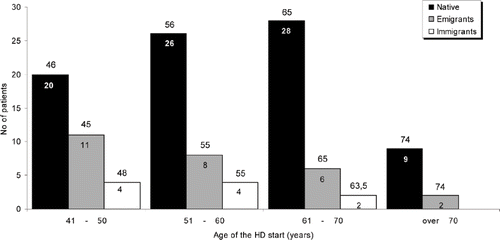
DISCUSSION
This study used an epidemiological approach to get information on the environmental exposure of the population of endemic settlements in the South Serbia. Five endemic settlements were selected, with the families and patients under medical supervision since 1964. The population of endemic villages around the South Morava River, admitted to HD treatment after 1974, was exposed to environmental toxicant(s) mostly from 1917 to 1941. The most intense effect of the environmental exposure was in that period, with ESKD in the patients' ages of 40–49. The exposure to environmental toxicants has diminished, so ESKD of BEN has become less frequent, and, in the older age, means were recorded of 72.5 in the period from 2004 to 2006. A different type of exposure was registered in some other endemic regions in Serbia and abroad.
Survival of BEN patients was better than in other kidney disease. In BEN patients starting HD from 1984 to 1998, it was significantly higher. This could be explained by less comorbid conditions in BEN patients. Decreased survival from 1999–2006 compared to previous period could be explained by an increased age, especially in the period from 2004 to 2006.
Two recent epidemiological studies carried out in Serbia and Bulgaria have suggested that the incidence of BEN may decrease in the near future.Citation[5],Citation[11] In a study performed to investigate the incidence of BEN patients on dialysis and BEN-associated mortality in endemic areas around the South Morava River in Serbia from 1978 to 1997, a marked decrease in the incidence of ESRD and BEN-induced mortality in the last ten years has been documented.Citation[5] It is now apparent that the prevalence of the disease did not considerably change for a long time, only later beginning to decrease in most (but not all) foci.Citation[12] Incidence shifted more and more to the older age groups, and clinical presentation had a protracted course independent over the last three decades from radically improved therapeutic modalities such as dialysis and kidney transplantation. Urothelial cancer in endemic areas around the South Morava River has the same trend, its incidence moving toward the incidence in general population, and the difference in their malignancy in endemic and nonendemic areas is less expressed.Citation[13] The trend of the disease implies diminished contact with the agent(s) and, consequently, a decrease of the disease importance in the national pathology.Citation[12–14]
This study clearly indicated time and strength of environmental exposure to the people of endemic settlements around the South Morava River.
ACKNOWLEDGMENT
This work was supported by the Ministry of Science and Environmental Protection of Serbia, grant 145004.
Notes
6. Velimirovic D. Contribution to the study of clinical course of endemic nephropathy. Ph D Thesis, University of Belgrade, 1984 (in Serbian).
REFERENCES
- Danilovic V, Djurisic M, Mokranjac M, Stojimirovic B, Zivojinovic J, Stojakovic P. Nephrites chroniques provoquees par l'intoxication au plomb par voie digestive (farine). Presse Med. 1957; 65: 2039–2040
- Stefanovic V, Polenakovic M. Balkan nephropathy. Kidney disease beyond the Balkans?. Am J Nephrol. 1991; 11: 1–11
- Radovanovic Z. Epidemiological characteristics of Balkan endemic nephropathy in eastern regions of Yugoslavia. IARC Sci Publ. 1991; 115: 11–20
- Radovanovic Z. Balkan endemic nephropathy in Serbia: Current status and future research. Facta Universitatis. 2002; 9: 26–30
- Cukuranovic R, Petrovic B, Cukuranovic Z, Stefanovic V. Balkan endemic nephropathy: A decreasing incidence of the disease. Pathol. Biol. 2000; 48: 558–561
- Bukvic D, Jankovic S, Djukanovic L, Marinkovic J. Survival of Balkan endemic nephropathy patients. Nephron. 2000; 86: 463–466
- Cukuranovic R, Savic V, Stefanovic N, Stefanovic V. Progression of kidney damage in Balkan endemic nephropathy: A 15-year follow-up of patients with kidney biopsy examination. Renal Failure. 2005; 27: 701–706
- Stefanovic V, Strahinjic S, Malobabic Z, Kostic S, Pavlovic NM. Maintenance hemodialysis in patients with endemic (Balkan) nephropathy. Proc. 4th. Simp. on Endemic (Balkan) Nephropathy, S Strahinjic, V Stefanovic. University Press, Nis 1979; 163–167
- Stefanovic V. Diagnostic criteria for endemic (Balkan) nephropathy. Current Research in Endemic (Balkan) Nephropathy, S Strahinjic, V Stefanovic. University Press, Nis 1983; 351–363
- Dimitrov SP, Simeonov AV, Ganev SV, Karmaus JJW. Is the incidence of Balkan endemic nephropathy decreasing. Pathol Biol. 2002; 50: 38–41
- Radovanovic Z. Epidemiology and aetiology of endemic nephropathy. Beograd: Zavod za udzbenike i nastavna sredstva, Z Radovanovic, M Sindjic, M Polenakovic, L Djukanovic, V Petronic, 2000; 22–138
- Marković N, Ignjatović I, Cukuranović R, Petrović B, Kocić B, Stefanović V. Decreasing incidence of urothelial cancer in a Balkan endemic nephropathy region in Serbia. A surgery based study from 1969 to 1998. Pathol Biol (Paris). 2005; 53: 26–29
- Stefanovic V, Cosyns JP. Balkan nephropathy. Oxford Textbook of Clinical Nephrology3rd, AM Davison, JS Cameron, JP Grunfeld, C Ponticelli, C Van Ypersele, E Ritz, CG Winearls. Oxford University Press, Oxford 2004; 1095–1102

